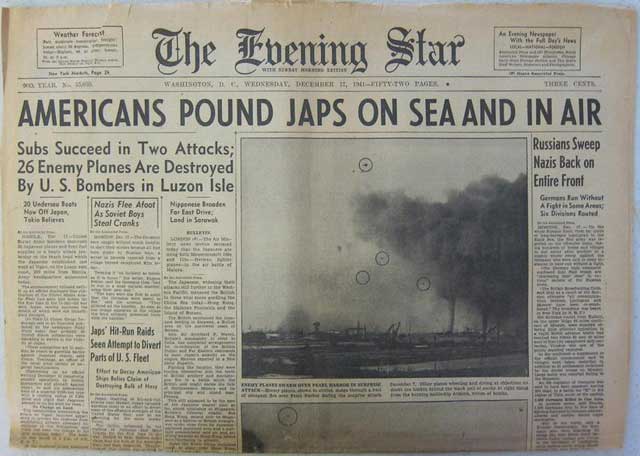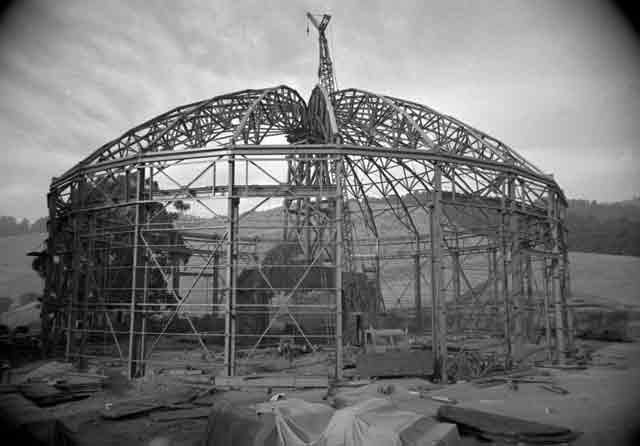Wednesday 17 December 1941
 |
| Imperial Japanese boats patrolling off Hong Kong Island during the battle of Hong Kong on December 17, 1941. |
U.S. Military: In a move that he knew was coming, CINCUS Admiral Husband E. Kimmel is relieved of command at Pearl Harbor by US Secretary of the Navy Frank Knox on
17 December 1941. While a suitable permanent replacement is found, Admiral William S. Pye, currently the commander of Battle Force, Pacific Fleet, replaces him on an acting basis as CINCPACFLT. This impacts operations because Kimmel has been planning a quick relief expedition to Wake Island under Admiral Frank Fletcher's Task Force 11. However, Pye judges it to be too risky and ultimately cancels the operation. The new CINCUS is Admiral Ernest J. King, Commander in Chief, US Atlantic Fleet (CINCLANTFLT). King gets a new acronym, COMINCH, for Commander in Chief, United States Fleet. Also relieved of command is the U.S. military commander responsible for the defense of U.S. military installations in Hawaii, Lieutenant General Walter Short, who suffers the further indignity of reduction in rank to his permanent rank of major general. Both men are ordered to return to Washington, where their actions prior to the Pearl Harbor attack will be investigated by the Roberts Commission under the direction of US Supreme Court Associate Justice Owen J. Roberts.
 |
| Local Hawaiian boys at the wreckage of a Japanese bomber on December 17, 1941. The plane was shot down by a United States P-40 plane during the December 7 attack on Pearl Harbor (AP Photo). |
Battle of the Pacific: While they prepare their forces for an invasion of Hong Kong Island, the last remaining British Commonwealth holdout in the area, the Japanese issue a surrender ultimatum. The local commander, Lieutenant General Sano Tadayoshi, commander of the 38th Division, does this by sending a captured British civilian woman along with her two dogs across to the island carrying his message. This is their second surrender offer, the first having been offered on 13 December. The British know their position is hopeless, but Governor Sir Mark Young responds that he "declines absolutely to enter into negotiations for the surrender of Hong Kong." The Japanese continue their invasion preparations.
 |
| After its initial hysteria during the first ten days of the war, the US media finally is beginning to return from fantasy to reality in its war coverage. The 17 December 1941 Poughkeepsie (New York) Eagle-News does not report any sinkings of phantom Japanese battleships. It also correctly headlines the Japanese shelling of Maui. Of course, the shelling was only a few perfunctory shells fired by a Japanese submarine at Maui that did no damage, but at least this is close to what is actually happening in the Pacific Theater. |
In Malaya, the Commonwealth forces briefly contest the Grik road but fall back under pressure. Indian III Corps begins a retreat to the Perak River line, where the British improvise the "Perak Flotilla" to prevent landings. Elsewhere, the Indian 12th Brigade Group proceeds to Kuala Kangsar. The British evacuate all Europeans from Penang, leaving behind extensive supplies, ships, and even a working radio station. It is a precipitous move that alienates the local population. Some consider this move the beginning of the end of British rule in the entire region.
 |
| Hawaiian civilians working with wreckage caused by the attack on Pearl Harbor, 17 December 1941 (AP Photo). |
In the Philippines, the Japanese invasion force at Legaspi, southeast of Manila, advances toward the capital. While moving along Route 1 toward Naga, it runs into advance Filipino Army units around Ragay. This is the first real contact between opposing forces in the Philippines. The US Army Air Force, already having abandoned Clark Field, begins withdrawing its 14 remaining B-17 bombers from Manila and flies them to Australia. The last bomber is gone by 20 December. Meanwhile, off Corregidor Island near Manila, 1881-ton US freighter Corregidor, loaded with Filipino refugees and troops heading for the southern Philippines, hits a U.S. mine late on the 16th and sinks during the early morning hours of the 17th. The number of casualties is unknown but is believed to be somewhere around a thousand people.
 |
| Aboard HMS Victorious at Scapa Flow, Christmas preparations are in full swing. "The Rev G W Dixon, MA, RN, who with other officers takes his turn as Censor Duty Officer, is well occupied handling the huge outgoing Christmas mail." (© IWM (A 6688)). |
The US Navy reinforces Midway Island by flying seventeen SB2U-3 Vindicators of Marine Scout Bombing Squadron 231 direct from Hawaii. While Midway is part of the Hawaiian Island chain, it is 1035 miles (1665 km) away. The flight takes 9 hours and 45 minutes, a record for single-engine aircraft. A PBY-4 Catalina of Patrol Squadron 21 leads the Vindicators there. The same Vindicators had been aboard USS Lexington (CV-2) en route to Midway Island on 7 December 1941, but the carrier turned back due to the attack on Pearl Harbor. The US Fleet now considers it too dangerous to expose the precious aircraft carriers to unknown dangers, so they remain behind in Hawaii.
 |
| The remains of Mitsubishi Zero fighter BII-120 that was shot down on Niihau north of Honolulu on 7 December 1941. This photo was taken on 17 December 1941. The plane was the plane involved in the famous "Niihau Incident" in which a Japanese fighter pilot briefly survived after crash-landing on the island (Pearl Harbor Memorial). |
The Australian military sends "Gulf Force" from Darwin to Ambon Island, Netherlands East Indies. The force is transported in three Dutch freighters, escorted by an Australian light cruiser and corvette. On Borneo, the Dutch send B-10 bombers based at Miri on Tarakan (base Singkawang II) against Japanese shipping offshore but score no hits. Later, three Dornier Do 24K flying boats renew the attack, but they lose one plane. However, one of the flying boats hits Japanese destroyer HIJMS Shinonome with two bombs and has a third make a near miss. The explosions blow the Shinonome apart and it sinks within minutes, taking all 229 crew with it. This is the first Dutch success in the Pacific Theater.
 |
| Not all US newspapers are reflecting reality. The Washington, D.C. Evening Star on 17 December 1941 announces in its headline that "Americans Pound Jap[anese] On Sea And In Air," which is a part wishful thinking and part fantasy. |
About 222 nautical miles southeast of Honolulu (108 miles southeast of Hawaii), HIJMS I-175 torpedoes and sinks 3,253-ton US freighter Manini. There are two deaths, with the survivors being picked up by US destroyers on 27 and 28 December.
 |
| A Luftwaffe reconnaissance Fieseler Storch lands in North Africa near Mechili on 17 December 1941. |
Battle of the Mediterranean: Early in the day, an Italian reconnaissance aircraft spots a Royal Navy unit heading west near Sidi Barrani. The Italian Navy is at sea escorting a convoy to Tripoli and heads toward the British force. The Axis sends planes to attack, but they score no hits. Italian Admiral Angelo Iachino heads for the British ships, secure in his superior firepower. Rear-Admiral Philip Vian in HMS Naiad withdraws, but Iachino pursues them and opens fire at 32,000 meters (35,000 yards). Vian then lays smoke and heads for the Italian ships, causing Iachino to break off the action after 15 minutes and head back to protect the convoy. The action is inconclusive, with the Italians only scoring one near-miss on destroyer HMS Kipling that kills one rating. Seeing the Italians heading west, Vian turns around and heads back to Alexandria. While neither side achieves much during the brief battle, the Italian convoy gets through to give General Erwin Rommel badly needed supplies.
 |
| The 184-inch cyclotron under construction at the Berkeley Lab on 17 December 1941 (Donald Cooksey, The U.S. National Archives). |
Applied Science: The United States Navy is busy working on airborne radar, still in its infancy but making huge strides. The Naval Research Laboratory takes a huge leap forward today by demonstrating the feasibility of the duplex antenna. It uses a single antenna for both transmission and reception of a radar pulse/echo. This greatly enhances the practicality of using airborne radar, which is extremely useful to the USN for locating U-boats while they are on the surface.
 |
| The National Christmas Tree Lighting Ceremony across the street from the White House on 17 December 1941 (White House Twitter). |
December 1941December 1, 1941: Hitler Fires von RundstedtDecember 2, 1941: Climb Mount NiitakaDecember 3, 1941: Hints of Trouble in the PacificDecember 4, 1941: Soviets Plan CounteroffensiveDecember 5, 1941: Soviets Counterattack at KalininDecember 6, 1941: Soviet Counterattack at Moscow BroadensDecember 7, 1941: Japan Attacks Pearl HarborDecember 8, 1941: US Enters World War IIDecember 9, 1941: German Retreat At MoscowDecember 10, 1941: HMS Prince of Wales and Repulse SunkDecember 11, 1941: Hitler Declares War on USDecember 12, 1941: Japanese in BurmaDecember 13, 1941: Battle of Cape BonDecember 14, 1941: Hitler Forbids WithdrawalsDecember 15, 1941: The Liepaja MassacreDecember 16, 1941: Japan Invades BorneoDecember 17, 1941: US Military ShakeupDecember 18, 1941: Hitler Lays Down the LawDecember 19, 1941: Brauchitsch Goes HomeDecember 20, 1941: Flying Tigers in ActionDecember 21, 1941: The Bogdanovka MassacreDecember 22, 1941: Major Japanese Landings North of ManilaDecember 23, 1941: Wake Island Falls to JapanDecember 24, 1941: Atrocities in Hong KongDecember 25, 1941: Japan Takes Hong KongDecember 26, 1941: Soviets Land in the CrimeaDecember 27, 1941: Commandos Raid NorwayDecember 28, 1941: Operation Anthropoid BeginsDecember 29, 1941: Soviet Landings at FeodosiaDecember 30, 1941: Race for BataanDecember 31, 1941: Nimitz in Charge2020


















